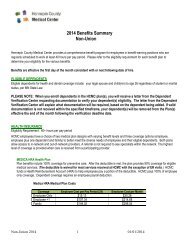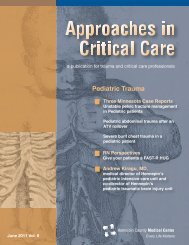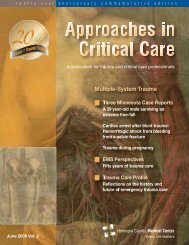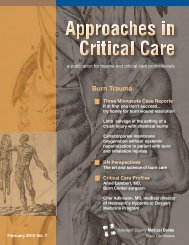Ischemic Stroke - Hennepin County Medical Center
Ischemic Stroke - Hennepin County Medical Center
Ischemic Stroke - Hennepin County Medical Center
You also want an ePaper? Increase the reach of your titles
YUMPU automatically turns print PDFs into web optimized ePapers that Google loves.
Case Reports<br />
She is continent of bowel and bladder. A left<br />
field cut is easily demonstrated and she has<br />
obvious left hemi-neglect on sensory testing.<br />
The patient is articulate and can express herself<br />
quite clearly but often interrupts others and<br />
appears to be somewhat disinhibited in social<br />
situations. The patient is scheduled for longterm<br />
physical and rehabilitation therapy to<br />
regain as complete functioning as possible.<br />
Discussion<br />
This patient, whose outcome was decidedly better<br />
than may have been estimated initially, presented<br />
several difficult management challenges.<br />
The patient presented with a history and physical<br />
examination very suggestive of stroke, a<br />
luxury not always available to the clinician.<br />
While clinical exam findings are unquestionably<br />
useful, the diagnosis is usually confirmed<br />
with imaging. A cranial CT scan without contrast<br />
is critical to differentiating ischemic from<br />
hemorrhagic stroke. An ischemic stroke can<br />
begin to show changes such as a hyperdense<br />
artery sign, sulcal effacement, loss of graywhite<br />
interface, mass effect, and acute hypodensity<br />
as soon as three hours after the event,<br />
but more often between 6-12 hours. Presence<br />
of early ischemic changes does not change<br />
the management with intravenous fibrinolytic<br />
therapy within the three-hour time window. An<br />
electrocardiogram helps diagnose atrial fibrillation<br />
(which account for 60% of cardio-embolic<br />
strokes) and myocardial infarction.<br />
Out-of-hospital providers and emergency<br />
physicians need to document as best as they<br />
are able the exact time of stroke onset and<br />
presence of any neurologic deficits, since<br />
these findings may rapidly progress or resolve<br />
by the time the patient arrives at the hospital.<br />
Such information is critical for the decision in<br />
administration of fibrinolytics. Management of<br />
blood pressure should use pre-established<br />
guidelines and will vary depending on whether<br />
the patient is a candidate for fibrinolytic therapy.<br />
The sBP shoud be less than 185 mmHg and<br />
the dBP less than 110 mmHg before giving fibrinolytics<br />
because of concern for increased<br />
intracranial hemorrhage risk with higher blood<br />
pressures. If fibrinolytics are given, strict blood<br />
pressure control is indicated, with the goal of<br />
having sBP 120 mmHg, according to the most recent<br />
American Heart Association guidelines. Aspirin<br />
given within 48 hours of the stroke onset has<br />
been shown to have mild efficacy in preventing<br />
early recurrent stroke but does not improve<br />
outcomes from the current stroke. Aspirin<br />
should be held for 24 hours after fibrinolytic<br />
therapy in case there is an intracranial hemorrhage.<br />
Improved outcome has not been shown<br />
for treatment with heparin for ischemic stroke<br />
in several clinical trials. Recent studies show<br />
no benefit from heparin, or a small potential<br />
benefit of heparin, that is counterbalanced by<br />
an increased risk of hemorrhage.<br />
In addition to the focal neurologic injury from the<br />
ischemic stroke itself, cerebral edema that<br />
develops following the insult can lead to intracranial<br />
hypertension and further devastating neurologic<br />
effects.<br />
The clinical manifestations of increased<br />
ICP include:<br />
Depressed level of consciousness<br />
Headache<br />
Vomiting<br />
Cushing's triad (bradycardia, respiratory<br />
depression, and hypertension)<br />
Additional focal deficits can be caused by<br />
ischemic injury or herniation. These manifestations<br />
are caused either by direct mass effects<br />
of the increased intracranial volume (e.g. herniation,<br />
Cushing's triad) or the decrease in<br />
cerebral blood flow caused by the ICP.<br />
4 | Approaches in Critical Care | December 2008
















